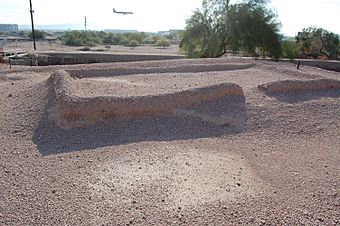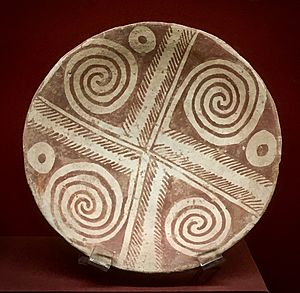Pueblo Grande Ruin and Irrigation Sites facts for kids
|
Pueblo Grande Ruin & Irrigation Sites
|
|

Ruins of a building at Pueblo Grande archaeological site.
|
|
| Location | 4619 E. Washington Avenue, Phoenix, Arizona |
|---|---|
| NRHP reference No. | 66000185 (ruin) 66000184 (irrigation sites) |
Quick facts for kids Significant dates |
|
| Added to NRHP | October 15, 1966 (ruin) October 15, 1966 (irrigation sites) |
| Designated NHLD | July 19, 1964 |
Pueblo Grande Ruin and Irrigation Sites are ancient places in Phoenix, Arizona. They show us how people lived long, long ago, even before Christopher Columbus came to America. Here, you can find old ruins and a big dirt mound built by early Native Americans. There are also parts of their amazing water canals. Today, the City of Phoenix takes care of these sites, and they are called the S'edav Va'aki Museum.
Contents
Discovering Ancient Phoenix
Long before modern Phoenix was built, a thriving civilization lived here. These people are called the Hohokam by scientists. The Tohono O'odham people, who are related to them, call them Huhugam. These early Native Americans built the structures you can still see at Pueblo Grande.
What Did They Build?
Pueblo Grande has a huge dirt mound with strong walls. This massive structure is made of over 20,000 cubic meters of earth. Imagine a giant pile of dirt! There were also many homes and at least three special ball courts.
Amazing Water Canals
The Hohokam people created some of the biggest and best canal systems in ancient North America. They were the first to use irrigation to grow crops in this dry region. The remains of their old canals are a key part of the Pueblo Grande site.
When Did People Live Here?
People lived at Pueblo Grande for about 1,000 years, from around 450 AD to 1450 AD. Then, like many other villages in the Phoenix area, it was left empty. Scientists still debate why these ancient people left their homes and irrigation systems. Some ideas include big floods, long droughts, wars, or diseases.
Cool Things to See

The Clever Canal System
The Hohokam built and used canals for nearly a thousand years. Pueblo Grande was perfectly placed at the start of several large canals on the north side of the Salt River. A natural bend in the river and some rocks pushed the water up, making it easy to send water into the canals. These canals carried water for many miles. The longest Hohokam canal started near Pueblo Grande and stretched over 16 miles to where Glendale is today. This probably made Pueblo Grande a very important village.
Other villages with platform mounds, like Pueblo Grande, were also built along the Salt River. They might have helped control the water flow to smaller villages. Keeping all these canals working would have needed a very organized community. You can still see parts of these canals at Pueblo Grande in an area called the Park of Four Waters.
Mysterious Ballcourts
Pueblo Grande might have had two ball courts. These were public places, probably used for special events and perhaps ritual ball games. They might have also been places for markets, where people traded goods. Some scientists think these ball games and courts were similar to those in ancient Mesoamerica (like Mexico), even though their designs were different.
Around 1100 AD, the Hohokam stopped using their ballcourts. Many courts were filled with dirt and trash. At the same time, platform mounds, like the one at Pueblo Grande, became more important in Hohokam villages.
The Big Platform Mound
The platform mound at Pueblo Grande started as two small, round mounds around 800 AD. Over time, people added stone walls and filled them with dirt and trash. They then covered the top with a smooth plaster made of caliche (a type of hardened soil) to create a flat platform. Buildings were then constructed on top of this platform. A 6 to 7-foot-high wall surrounded the mound, limiting who could go up. Some scientists believe these mounds were used for special ceremonies. The Pueblo Grande platform mound is one of the largest ever built by the Hohokam.
There might have even been an ancient observatory on top of the Pueblo Grande platform mound. One room had doorways that may have lined up with a natural hole in the Papago Buttes during the winter and summer solstices. This would have helped them track the seasons.
Old records also mention a "big house" at Pueblo Grande, similar to the famous one at Casa Grande Ruins National Monument.
The S'edav Va'aki Museum
In 1924, Thomas Armstrong gave the platform mound and about 5 acres of land to the City of Phoenix. Soon after, Phoenix bought another 10 acres south of the mound, which they called "Park of Four Waters." This became part of the Pueblo Grande Museum and Archaeological Park. In 1929, Odd S. Halseth became the director of Pueblo Grande and Phoenix's first City Archaeologist.
The Pueblo Grande Museum and Archaeological Park grew over the years. In 1964, it was named a National Historic Landmark. It has two main parts, which were once separate but share the same history. Both were officially listed in the National Register of Historic Places in 1966. Today, the museum has exhibits and stores many ancient items found in Phoenix. On March 23, 2023, the museum's name was changed to S'edav Va'aki Museum.
Gallery
See Also
- Hohokam – other cool sites:
- List of historic properties in Phoenix
- Phoenix Historic Property Register
























